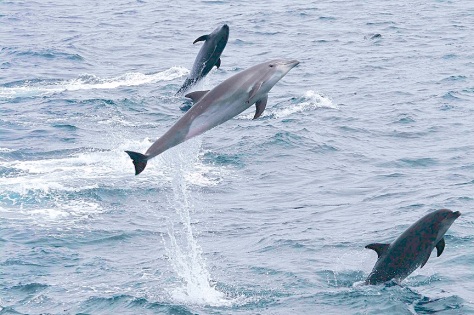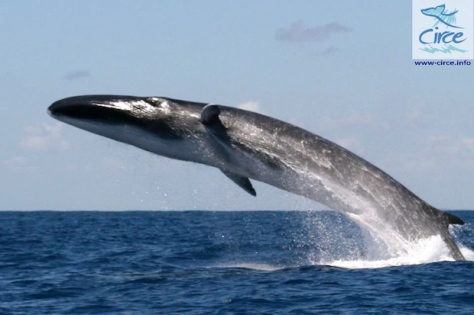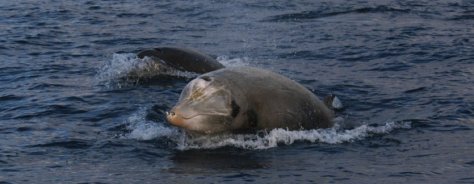Did you know that in the Mediterranean Sea habitually lives 8 species of cetaceans, among dolphins and whales; in addition to other visitor and spontaneous species, such as the killer whale? In this post, a new version of “Cetaceans in the Catalan coast“, the first post published in this blog, I will give more information about the cetaceans that live in this small sea.
INTRODUCTION
Cetaceans originated 50 million years ago in the ancient Tethys Sea, from terrestrial mammals. Approximately, there are 80 living species in the world, but only 8 of them live habitually in the Mediterranean and other species are present only in some seasons or sporadically.
HABITUAL CETACEANS OF THE MEDITERRANEAN SEA
STRIPED DOLPHIN
Striped dolphin (Stenella coeruleoalba) is a cetacean with a black or bluish grey colouration in the back and white in the ventral part. There is a black line from the eye to the anal region through each side, and another one from the eye to the pectoral fin. Mediterranean striped dolphins are slightly smaller than their neighbours from the Atlantic, and achieve a maximum length of 2.2 m.

They may live in big groups, till hundreds of individuals. Anyway, in the observations that I have done in the Mediterranean, groups included from 5 to 50 animals. They are very acrobatics and they can jump 7 meters above the sea surface.
Striped dolphins are common in both Mediterranean basins, specially in the open sea, being so many abundant in Ligurian Sea, Gulf of Lion, Alboran Sea (between Andalucía, Spain, and Morocco) and the Balearic Sea (between the Iberian Peninsula and the Balearic Islands).
This is the most abundant species in the Mediterranean (about 117,000 animals in the western basin), but they are in a vulnerable status of conservation due to the affection by morbillivirus, pollutants such as organochlorine compounds and fishing devices.
BOTTLENOSE DOLPHIN
Bottlenose dolphins (Tursiops truncatus) maybe are the most known for the population because they are the protagonist of some movies and they are the most common cetacean in captivity.

Their robust body is grey, clearer in the sides and white in the abdomen. Bottlenose dolphins are 4 m long.
Their groups, integrated by females and offspring or young males, range from 2 to 10 animals. They live in all the coasts of the Mediterranean Sea.
Their conservation status in the Mediterranean is vulnerable. It is though that their population is about 10,000 animals. Competence with commercial fisheries, bycatch and water pollution are among their threats.
SHORT-BEAKED COMMON DOLPHIN
Short-beaked common dolphin (Delphinus delphis) is easily recognisable for the colouration of its body: dorsal region is dark and sides are cream-coloured or yellow, and constitute a V in the half of the body. Like striped dolphins, they are also small animals (2-2.5 m).

They live in numerous groups in open waters, from 10 to 200 animals, but sometimes groups of several thousands have been seen.
They enjoy with boats:
Despite their name, it is difficult to observe them because they are endangered in the Mediterranean. In the last 40 years, their population have been reduced by half. There are several reasons: lack of preys due to competence with fishers, bycatch, habitat degradation, sound pollution and high concentrations of pollutants.
FIN WHALE
Fin whale (Balaenoptera physalus) is the biggest whale in the Mediterranean and the second one in the world.

Fin whale’s head is V-shaped, wide and flatten. It is dark grey in the back and white in the abdomen, but asymmetric in the jaws: left side is dark grey and right side is white. Dorsal fin is short and placed in the last third of the body. In the moment of diving, caudal fin is not shown out of the water. Blow may be 8 meters height and narrow. Their maximum length is 24 m.
They are usually seen alone or in small groups (normally mother and calf) in open waters. In the Mediterranean, they are most frequently sighted between Balearic Islands and Ionian Sea, being specially abundant in the Gulf of Lion.
According to IUCN, it is a vulnerable species in the Mediterranean, but it is endangered worldwide. The Mediterranean population includes 5,000 adults. They are victims of strikes with ships, high DDT concentrations, acoustic pollution due to seismic surveys and bycatch.
Have you seen this fin whale rescue from Fuerteventura?
SPERM WHALE
Sperm whales (Physeter macrocephalus) are the biggest toothed whales and one of the biggest cetaceans in the Mediterranean.

Sperm whales have a rounded or triangular hump instead of a dorsal fin, which is followed by six exaggerated “knuckles”. An important clue for its identification is the blow: it is a bushy blow directed low, left and forwards. Head, which is square, represent 1/3 of the total length of the body. It is dark or grey, with the lower part of the mouth white. To dive, they show the caudal fin out of the water. They may be 20 long.
Their groups are composed by females and their offspring, other groups of young males and adult males are solitary. The number of animals per group ranges from 10 to 15, but smaller groups also exist. They are usually seen in oceanic waters of all the Mediterranean.
It is an endangered species in the Mediterranean due to they are accidentally captured in fishing nets, by strikes with vessels and the annoyance provoked by marine traffic. It is estimated that live some thousands in the Mediterranean.
Have you seen this video of a sperm whales that “adopt” a deformed cetacean?
RISSO’S DOLPHIN
Risso’s dolphin (Grampus griseus) is grey when is born, but becomes paler with age for the presence of scars that do not disappear. They might measure 4 m.

Generally, they live in groups of 3-50, despite sometimes groups of some thousands have been spotted. In the Mediterranean, it is widely distributed in open waters, being more abundant in the western basin, where they prefer continental slope and submarine canyons.
Their status of conservation is unknown, but bycatch and acoustic and chemical pollution affect them.
LONG-FINNED PILOT WHALE
Long-finned pilot whale (Globicephala melas) is the biggest dolphin species in the Mediterranean, since it may achieve 6 m. Black in general, this pilot whale has a anchor-shaped ventral patch. Its flippers measure one fifth of the length.

Their groups range from 10 to 60 animals, but also several thousands. Groups include several generations of females with their calves. In the Mediterranean, it is abundant in the western basin, specially in the Strait of Gibraltar and Alboran Sea.
There is deficient data to evaluate its status of conservation. Anyway, it is known that are threatened by bycatch, strikes and acoustic and chemical pollution.
CUVIER’S BEAKED WHALE
Cuvier’s beaked whales (Ziphius cavirostris) are dark grey or brown, paler in the head. Their head is bulky, and the beak is not much marked. They may be 7 m long.

They usually live in groups of 2-7 individuals or alone, in deep oceanic waters.
It is difficult to observe them due to the little activity in surface, reason that can explain why there are not enough information to evaluate their conservation status. It is known that are specially sensible to acoustic pollution, both military activities or seismic surveys. Moreover, the ingestion of plastic and bycatch also affect them.
KILLER WHALES IN THE MEDITERRANEAN?
Killer whales (Orcinus orca) are one of the most fascinating cetaceans. They live in polar and tropical waters, from the coast to open sea.

In the Mediterranean, however, they are only considered residents in the Strait of Gibraltar, with a size population of 32 whales. Their presence in the Strait, it is believed that is linked to the presence of bluefin tuna, their food.
Did you know that they use different dialects to communicate each other? Did you know that homosexual behaviours have been described in this species? Albino killer whales have been reported.
Their status of conservation is unknown, but direct death by fishers, reduction of their preys, annoyances and habitat degradation are among the causes of their reduction.
REFERENCES
- CRAM: Cetacis
- Day, T (2008). Guía para observar ballenas, delfines y marsopas en su hábitat. Ed. Blume
- Gobierno de Canarias: Curso de Observación de Cetáceos
- IUCN (2012). Marine Mammals and Sea Turtles of the Mediterranean and Black Seas. Gland, Switzerland and Malaga, Spain: IUCN
- Kinze, CC (2002). Mamíferos marinos del Atlántico y del Mediterráneo. Ed. Omega
- Lleonart, J (2012). Els mamífers marins i els seus noms. Terminàlia, 5, 7-25
- Notarbartolo di Sciara G. (compilers and editors) (2006). The status and distribution of cetaceans in the Black Sea and Mediterranean Sea. IUCN Centre for Mediterranean Cooperation, Malaga, Spain.
- Cover picture: Scuba Diver Life










